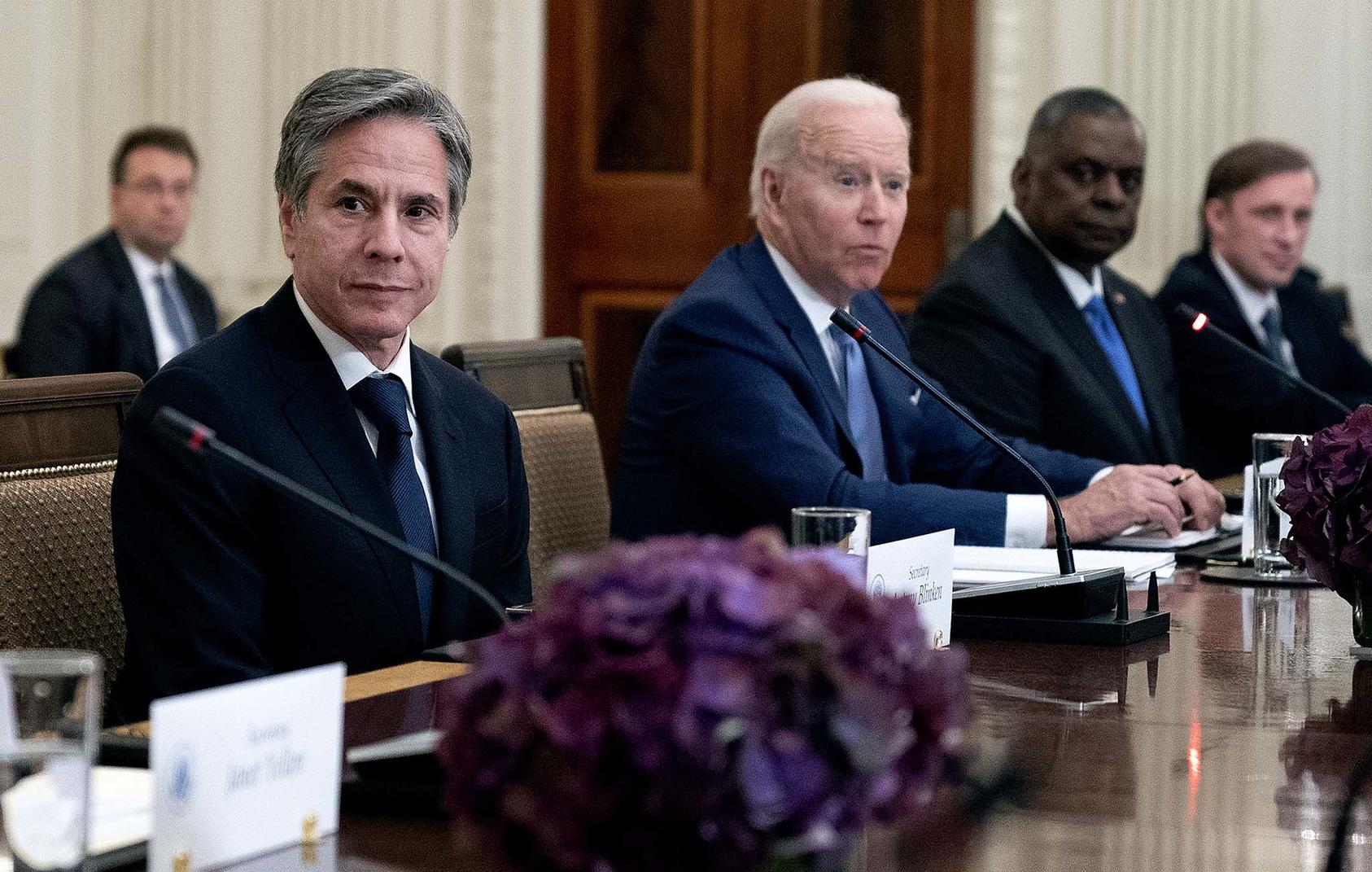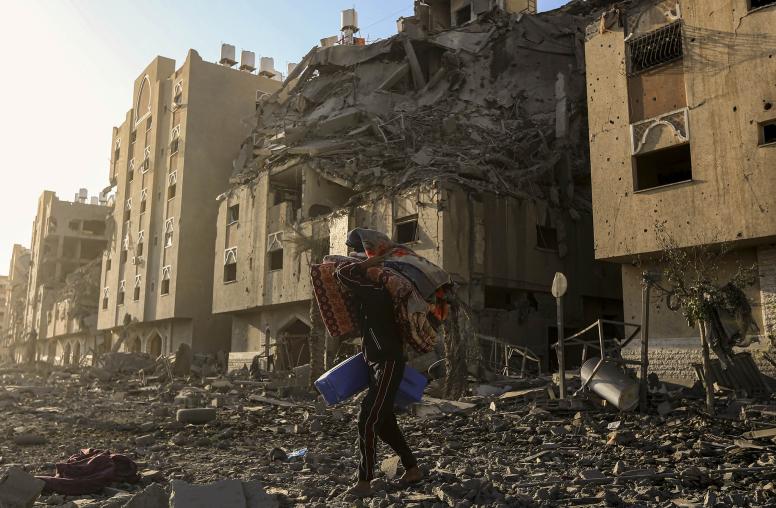10 Things to Know: Biden’s Approach to the Israeli-Palestinian Conflict
Will the administration’s emerging policy be enough to advance peace in this enduring conflict?
Coming into office, the Biden administration was clear that the Middle East would largely take a backseat in its foreign policy agenda. But recent developments in Jerusalem and the 11-day war on Gaza forced the Israeli-Palestinian conflict back into the forefront of international attention and revealed elements of the administration’s approach to the conflict. U.S. policy on the conflict has long been a point of bipartisan harmony, with more consensus than contention. The Biden administration’s emerging policy largely aligns with past administrations’ policies, with a few notable differences. But can this approach advance peace amid this protracted conflict?

What We Know About the Administration’s Approach
1. The Biden administration has not prioritized the Israeli-Palestinian conflict on its foreign policy agenda.
At the outset of the administration’s tenure, the Iranian nuclear file and the war on Yemen were the only prioritized issues in the Middle East. For decades, however, the Israeli-Palestinian conflict had been at the forefront of U.S. policy in the region. President Obama appointed George Mitchell as his Middle East special envoy within 48 hours of his inauguration, signaling his intention to prioritize the conflict early on. In contrast, President Clinton presented his parameters for a permanent status agreement to resolve the conflict in the final weeks of his term. President Trump, who spoke early on in his term of forging “the deal of the century,” moved the U.S. embassy to Jerusalem; reversed previous U.S. positions on settlements and the Golan Heights; presented a detailed plan for resolving the conflict; and invested significant political capital in establishing and advancing Israeli relations with countries in the region and beyond.
2. The Biden administration has until now avoided detailed prescriptions, confining policy articulation to its broadly framed end-game vision.
President Biden and Secretary of State Blinken have indicated on numerous occasions that the two-state solution is the only way to resolve the conflict. However, the administration has not yet gone into any detail regarding such core issues as Jerusalem, final borders, refugees and security. By contrast, the prior administration outlined a detailed framework for resolving the conflict, much as was done — though starkly different in vision from the Trump plan — during the Obama, George W. Bush and Clinton administrations. This plan was considered a non-starter for the Palestinians given what was more widely recognized as its heavy bias toward Israel’s positions. We may yet see a more concrete set of prescriptions emerge or rearticulated. For now, the administration seems focused on resetting the destination.
While the Trump plan ultimately nodded to a two-state framing, it strayed far from the concept as long-accepted by the international community. By contrast, while refraining from offering details, the Biden administration is nodding toward a more traditional understanding of two states through their insistence on constant use of the term and signals on Jerusalem.
3. The Biden administration seeks active engagement with the Palestinians to advance progress toward conflict resolution.
The administration is looking to reset the relationship with the Palestinian leadership in Ramallah after the prior administration closed the U.S. consulate in Jerusalem — the longstanding U.S. mission to the Palestinians — and halted almost all assistance provided to the Palestinian people. Harkening back to the era of U.S.-Palestinian engagement ushered in with the establishment of the Palestinian Authority in 1994, the Biden administration has partially resumed assistance and during his trip to the region, Blinken asked Israel to allow the United States to reopen the consulate. The administration has also been forthcoming on the reconstruction of Gaza, on the condition that it does not benefit Hamas.
4. The Biden administration exerted pressure on Israel to end the war on Gaza.
Soon after the cease-fire in Gaza was announced, Biden said that he spoke to Prime Minister Netanyahu six times in a few days. This approach was lower profile than the 2012 and 2014 U.S. engagement when the Obama administration sent Secretaries of State Clinton and Kerry, respectively, to the region to try to bring about a cease-fire. However, reports indicated that Washington’s patience was running thin and that the last few calls were characterized by firm and clear warnings to Netanyahu. This marks a reversal from the Trump administration’s approach of maximum latitude to Israel. Indeed, former U.S. ambassador to Israel, David Friedman, recently said that a “Trump administration would have given Israel free reign to defend itself.”
5. The Biden administration is sending clear messages that Jerusalem is still on the table.
During Blinken’s visit to Israel, he announced that the consulate they seek to reopen would be in Jerusalem. He also warned Israeli leaders that such steps as evicting Palestinian families from East Jerusalem could “undermine even further the difficult prospect of two states,” and “spark renewed tension, conflict and war.” While refraining from specification of Jerusalem’s final status, the message is a clear back track from the Trump plan that stipulated that “Jerusalem will remain the sovereign capital of the State of Israel, and it should remain an undivided city.”
6. The Biden administration views Israelis and Palestinians alike as parties with rights and interests.
Biden and members of his administration have repeatedly said that the United States believes that Palestinians and Israelis “deserve equal measures of security, freedom, opportunity and dignity.” This parity is a departure from the approach of the prior administration, in which senior officials described numerous issues recognized by the international community as Palestinian rights as only aspirations.
7. The Biden administration considers settlement activity and annexation unilateral actions that undermine the prospect of a two-state solution.
Blinken said that the United States opposes any steps by either side that “either risk sparking violence or … ultimately undermine the prospect for returning to the pursuit of two states.” He listed settlement activity among such steps, alongside home demolitions, evictions, incitement to violence and payment to terrorists. The framing carries echoes of many prior U.S. administration public statements that have refrained from referring to settlements as illegal, in favor of phrases such as “obstacle to peace,” or “ill-advised.” It departs from the Trump administration, under whose plan not a single settlement was to be dismantled and Israel would have been allowed to extend its sovereignty over all Israeli settlements. While generally avoiding definitive policy pronouncements related to the conflict, in recent days Biden reportedly outright rejected support for any future plans by Israel to annex West Bank territory. Under the Trump plan, Israel would have been allowed to annex 30 percent of the West Bank to incorporate settlements and the Jordan Valley. The Biden administration has been firm on the need to protect Israel’s security, but has been silent on the role of the Jordan Valley in that equation, even as it has nodded to the security value of the Golan Heights — an area that the Trump administration recognized as part of Israel.
8. The Biden administration does not believe that Israeli-Palestinian negotiations are possible now.
Blinken divided the administration’s next steps on the conflict into three clear sequential phases that would be a precursor to any efforts to bring the parties back to the negotiating table:
- Focus on humanitarian and urgent reconstruction needs in Gaza.
- Address Israeli and Palestinian actions that will reduce tension and minimize or prevent renewed violence.
- Build on the prior steps, over time, to improve people’s lives and add a sense of dignity and hope.
Blinken added his aspiration that these steps might produce a better environment in which a resumed effort to achieve a two-state solution could take place. This reflects a more gradual approach than taken by the prior two administrations in which we saw robust efforts via special envoys and final status negotiations in the case of Obama, and a plan around which negotiations were expected by Trump.
9. The Biden administration seeks engagement with other stakeholders.
The Biden administration indicated that it will be cooperating with other stakeholders on a range of global issues, including the Israeli-Palestinian conflict. Despite questions pertaining to the effectiveness of the Middle East Quartet (United States, Russia, the EU and the U.N.), this multilateral body, first convened under the George W. Bush administration, has resumed meeting after a period of dormancy driven by the Trump administration’s preference to work on this issue unilaterally. Moreover, Blinken said that the United States will work with its partners to address the urgent needs in Gaza, and to address some of the underlying causes that could spark another cycle of violence.
10. The Biden administration supports normalization deals between Israel and Arab countries but is not prioritizing pushing more forward.
The Biden administration has announced its support for the normalization agreements signed under the Trump administration and has expressed its hope that they can contribute to achieving Israeli-Palestinian peace. Pursuit of regional agreements has been a component of U.S. diplomacy on this conflict dating back to the Madrid process under President George H. W. Bush and immediately prior to the Trump administration was pursued by Secretary Kerry in 2016. However, it seems the Biden administration considers addressing the ongoing Israeli-Palestinian friction as more deserving of its current attention than avid pursuit of additional Arab-Israeli agreements. The Trump administration seemingly viewed the agreements as a tool to pressure Palestinians to accept its vision of a final settlement.
Can Biden’s Approach Advance the Prospects for Peace?
For now, the Biden administration’s approach to the conflict appears to be one of cautious gradualism. The immediate focus is on working with Egypt and other partners to stabilize the current fragile cease-fire. It remains to be seen whether the administration will consider moving the conflict’s priority up on its foreign policy agenda, and whether its policies will advance the prospects of peace. But recent reports suggest the administration is considering appointing an envoy for the Middle East.
In the meantime, several tests will present themselves. The administration is yet to clarify its position on the linkage between reconstruction and the political process. This will be crucial to instill hope, particularly among Palestinian and Israeli youth. In addition, a ruling is soon to be made by the Israeli Supreme Court on a case seeking to evict Palestinian families from the East Jerusalem neighborhood of Sheikh Jarrah. The court has ordered the Israeli attorney general to submit a legal opinion on the case within the next two weeks before the court considers its ruling. The outcome could become the trigger for another explosion that both parties, the United States and the broader international community should hope and seek to avoid.
There are several steps the administration could take, short of expeditiously restarting negotiations, to address ongoing conflict drivers and prevent violent setbacks. Without a shift in this direction, the United States and the international community are likely to find themselves in a constant firefighting mode, frequently expending diplomatic, financial and political capital that never moves the conflict off its destructive path.



